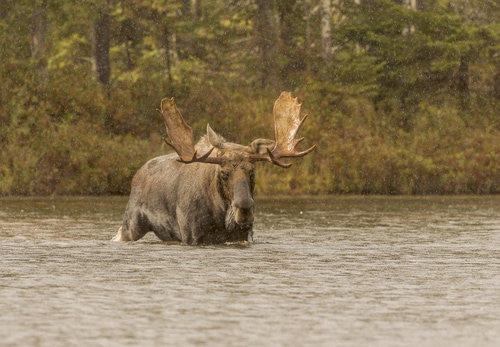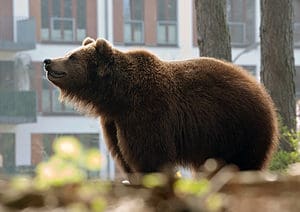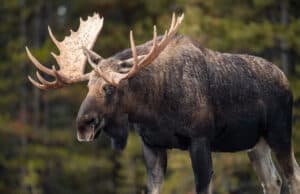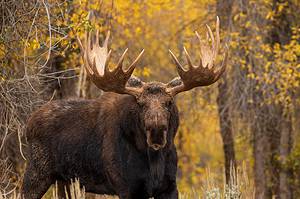Quick Answer:
- Moose shed their antlers to conserve their energy.
- Their antlers can weigh up to 60 pounds, so become a weighty burden when winter approaches.
- After the rut, which typically takes place in the Autumn, a moose no longer needs its antlers to compete for mating rights.
Even though it’s an annual thing, it’s rare to see moose shed their antlers on video. Shedding antlers is rare to see, period, probably because it’s such a quick process. Nevertheless, it’s a common and necessary occurrence with moose and all deer species.
Moose shed their antlers as a matter of energy conservation. Their gargantuan antlers are capable of reaching 60 lbs in weight, an enormous burden on them as the winter approaches. Instead, moose have to conserve their energy to survive the harsh sparsity of a cold, northern winter.
However, it’s not quite that simple, at least in terms of the process. A moose doesn’t just decide one day to throw its antlers off and move on. Like most things in the natural world, it’s a process. Much like the process of growing them back, which is a stunning occurrence in and of itself.
What Causes Moose to Shed Their Antlers?
A bull moose is capable of growing its antlers to a width of 6 feet, weighing roughly 50 lbs to 60 lbs. That’s an enormous antler rack by any standard. It’s even more insane when you consider the fact that a moose is capable of growing its antlers back at a rate of a full pound per day. That’s a lot of energy expenditure no matter how you look at it.
Energy expenditure plays a major role in why moose shed their antlers, to begin with. It’s simply a matter of necessity. A moose is not a small animal. A male moose (bull) will reach over half a ton in adulthood and stand over 7′ tall at their withers.
Moose are the largest species of deer and it takes an incredible amount of energy just to move around and go about its daily business. As the winter approaches, vegetation (the primary diet of a moose) becomes sparse thanks to the winter chill. Without food, a moose has no real way to replenish its energy.
Two things inform the moose as to when to shed its antlers. The first is the reduced daylight as winter approaches. The second is the moose’s hormones. Moose shed their antlers after mating season. There is no more competition for female moose and testosterone drops.
The precipitous drop in testosterone weakens the antlers at the pedicles (the point where the antlers grow out of the head. Eventually, they weaken so much that the moose simply shakes them off. The antlers fall where they lay and the moose moves on.
Benefits of Moose Shedding Their Antlers
The immediate benefit is the conservation of much-needed energy throughout the winter months. Moose are northern creatures, where the winters are harsher and last longer than they do in the south. A moose consumes roughly 35 lbs of vegetation per day. No less than 25% of the energy converted from that food is expended on growing the antlers.
The moose won’t have to worry about new antlers breaking through for several weeks. Another benefit of losing the antlers is convenience. The antlers serve two purposes: Luring females and combatting other males. After the rut, which typically takes place in the Autumn, a moose no longer needs to do either.
Once the rut is over, the moose’s antlers are nothing more than a drag, expending precious energy both through additional growth and the weight of hauling them around. The velvet that coats these antlers also reforms after several weeks have passed.
The moose will continue growing its antlers until they are larger and heavier by the time the next rut rolls around. By then, the rack is massive, even larger than it was throughout the previous rut. Essentially, the moose’s odds of attracting a mate and scaring off lesser bulls improve each season.
Do Moose Bleed When They Lose Their Antlers?

eyeballing the camera.
©Donna Dewhurst / Public Domain – Original
Yes, when moose shed their antlers, they bleed some. It’s not gushing blood or anything but there is enough bleeding that a scab forms over each pedicle and it slowly heals over the next few weeks. The new antlers form from those pedicles, along with reformed velvet that remains on the antlers until the rut.
As the rut approaches, the moose will shed the velvet, which looks like a bloody ruin halfway through the process. If you happen to come across a moose throughout this time frame, you might assume it just finished goring some wild animal or another. It may look quite frightening to the uninitiated.
As the antlers continue to grow, approaching the rut, the velvet grows with it, serving as a kind of skin over the entirety of the antlers. When the rut is close, the velvet becomes infuriatingly itchy as it dries out.
The moose will do what all deer do during this period and start rubbing their velvety antlers against the trees. This satisfies the itch while shredding the velvet from the antlers. Most of the time, giant strips of bloody velvet hang from the moose’s antlers, resembling something straight out of a horror movie.
Does it Hurt When Moose Shed Their Antlers?
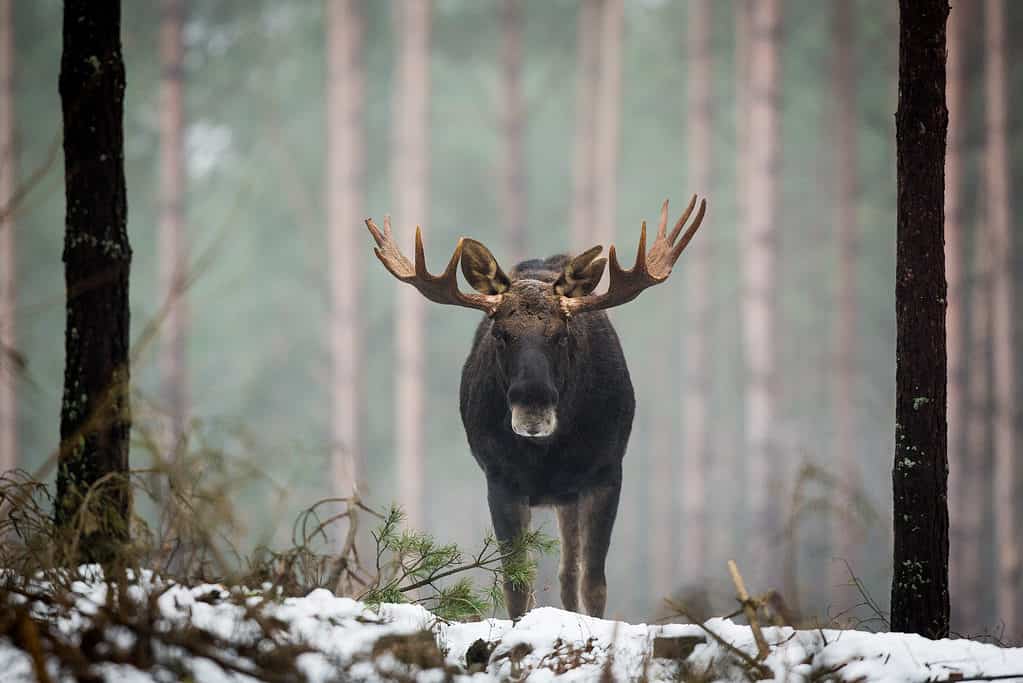
The largest moose ever caught in the world belonged to the Alaskan Yukon moose subspecies.
©Szczepan Klejbuk/Shutterstock.com
It’s not very painful when moose shed their antlers. Now, if there is a slight pressure or a pinprick lance of pain when a moose shakes them off, that’s something we may never know since none of us has ever been nor will ever be a moose.
We don’t think it hurts much based on a few factors. Once the antlers reach their maximum size for the season, the blood supply is cut off from them. They dry up inside and become harder. This corresponds with the drying velvet, which we do know becomes itchy.
Sometime between the beginning and end of December, the point of connection (antlers to pedicles) is flooded with what we call, ‘osteoclasts,’ cells whose sole mission is to destroy the attachment between the antlers and the pedicles.
If you watch the above video, you will see how easily the moose slings its antlers off, with a shake of the body and a quick twist of the head. The osteoclasts did their job well, making it easy and seemingly painless for the moose to discard.
Final Thoughts on Reasons Why Moose Shed Their Antlers
The reasons are slim on the ground. Moose shed their antlers simply to conserve energy over a harsh winter. Considering where moose typically range, winters are long and sometimes pretty harsh.
As with nature as a whole, everything in a moose’s life is cyclical. They grow antlers, shed the outer velvet, use the antlers to attract mates and combat opponents, shed the antlers, and go through the entire process again the following season.
Moose are endlessly fascinating and massive creatures. Although their antlers are equally massive, they are quite disposable, only useful for a single glance from a female that lures her in or to scare off that new guy with smaller antlers. Maybe next year new guy.
Thank you for reading! Have some feedback for us? Contact the AZ Animals editorial team.

